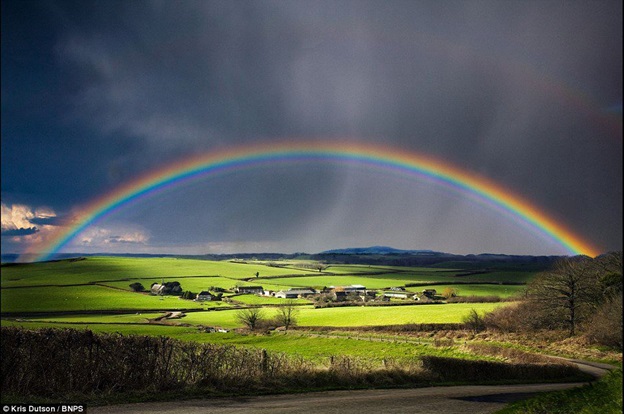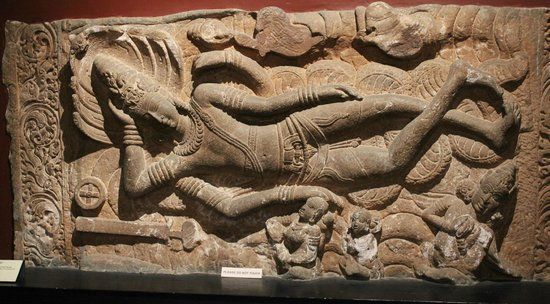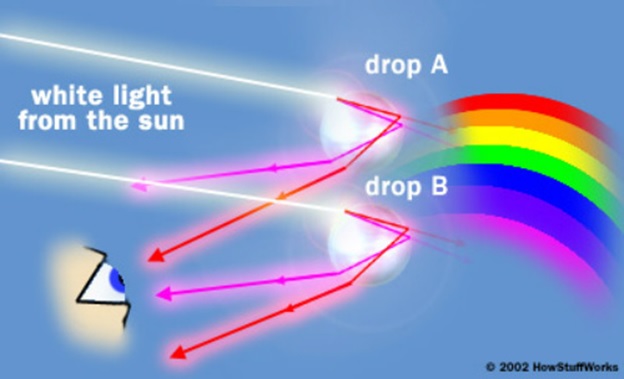Is jiva a creation of Vishnu? Are they different from Vishnu? While they appear different, are they equal to one another? Do the differences among them vanish at Moksha?
In as much as jiVa is dependent on Vishnu for sustenance and deliverance, jiva is considered to be unoriginated -anaadi. All Indian philosophers including Shri Madhwacharya agree on this. This is a key factor in building up the nature of jiva, its purpose and relationship with Vishnu.
At fundamental level, jiVa is the entity that has the ‘doer-ship’, owns the ‘enjoyer-ship’ and consequently faces the cycle of pleasure and pain. Shrimad Ananda Theertha writes: ‘अहिमितरेवयो वेद्यःस जीव इित कीितर्|तःस दुखी स सुखीचैवपात्रंबन्धमोक्षयोः |इित च परमाश्रुितः’– that, which has a sense of “I am”, suffers pain, enjoys pleasures, feels bound by them is Jiva that needs liberation.
Shri.Madhwaacharya proposes a Bimba- Pratibimba model, an Object-Reflection model to establish the relationship between Vishnu and jiVa. He has a caveat, though. Jiva is a reflection of Vishnu, without any reflecting medium. He quotes Paingi Sruti to establish this-
सोपािध अनुपािधश्चप्रितिबम्बो िद्वधेयते|
जीव ईशस्य अनुपािधिरन्द्रचापोयता रवेः’ इित पैङ्गी श्रुित
“There are two types of reflected images-one with a conditioning agent and other without it. JiVa is a reflected image of the Lord, like a rainbow, without a conditioning agent”
How does a Jiva become reflection (Prati Bimba) of Vishnu (Bimba), without an adjunct or conditioning agent Upadhi? How can an object create a reflection without a medium? Doesn’t the rainbow example show that there is a conditioning medium? Are all the jiva same as one another or completely different?
Shrimad Ananda Theertha’s suggestion is that jIva’s own intrinsic nature acts as the conditioning adjunct, to make it to the type of jIva it is. He calls it swarUpa upAdhi. What is this Swaupa Updahi or self-conditioning adjunct of Jiva that defines it, differentiates it and helps dissolve in Shri Hari’s grace? How do we see that it is connected to Advaitha?
This search for harmony between two philosophies require detailing of how this Bimba-Pratibimba model of Shrimad Ananda Theertha plays out.
The broad steps to be covered are:
- First, we need to establish why this has to be anaupAdhika aabhAsa, an adjunct-less reflection;
- Second, we need to prove how the jIva swarUpa, intrinsic nature, itself can act as an adjunct;
- Third, rationally explain if and why this relationship will continue even in moksha.
- Fourth, as an incremental thought explore how swaruPa upAdhi even acts in making jIvas to be inherently different.
- Fifth, analyze, how this rationally and logically explains the gradation of jIvas, the Taratamya model
- Finally see how this aligns with Advaitha.
The basis for this rainbow model flows from Brahma Sutra 2.3.13
औं तदभिध्यानादेव तु तल्लिङ्गात्सः औं-
“Aum, because of His reflecting only Aum.”
While commenting on this sutra Shrimad Acharya quotes Shruti:
यमप्येतेभुवनंसांपरायेनो हिरध्रुर्तःमीहायुषेत्तुदेवः
य इदंसवर्ंिवलापयित स हिरः परः परात्मा इत्यािद श्रुितभ्यःइित ऎव शब्दः
“The entire schema of universe is originated and dissolved into Shri Hari. How do jIva fit into this schema? In as much jIva are anAdi, they are but reflections of Shri Hari- aabhaasa”
This gives us a Royal Road that connects Tatva Vaada & Advaita. Given that Abhasa has many meanings including reflection, phantom image, erroneous perception, semblance, etc. it leads us to understand Acharya’s definition. This also demonstrates the depth of his thought. The foundation points behind the Bimba-Prati-bimba vaada are two: jIva were anAdi ‘un-originated’ and are intelligent.
Advaita argues that jiva were pratibimba of Brahman- Ishwara, as a mistaken self-identity, as being different from it through conditioning adjunct Avidya ignorance.
Shrimad Ananda Theertha would have none of it. He would ask:
अज्ञात अिखल संवेत्तुर घटतेन कु तश्रनःउपािध भेदाद्घटत इित चेतसास्वभावतः अज्ञानतो वा? द्वैतस्यसत्यता स्वत एवचेत्?
“From where did the conditioning ignorance come from? If it is outside, there is no more advaita; if it were internal, how did ignorance obscure the intelligent Brahman?”
So, for him jIva had to be anAdi, real and separate from Brahman Ishwara – but dependent on Ishwara. His conviction was based on Rg Veda 7.47.18: रूपं रूपंप्रितरूपं बभूवतदस्य रूपंप्रितचक्षणाय – ‘He is the form in every form, that needs to be perceived in every form’
He starts building the jIva model slowly from this – it is a shadow of Shri Hari, छाया यथा पुम्सदृिशपुमधीना च दृश्यते(AV) in that it has similar form but dependent on Shri Hari as Bimba. It is not inert though, as it has intelligence (क्किचत्चेतनेिपछाया शब्द
प्रयोगः प्रितिबम्बत्व साम्याद्भवित)
If the jiVa are similar to Vishnu, real, anAdi but dependent on Vishnu, how did this come to being? Why did this come to being? Why is it bound to samsara? Why are the jiVa different from another?
To address all these questions, he brings up a literally colorful analogy – a rainbow. We saw him quote Paingi Shruti –
….’सोपािध अनुपािधश्चप्रितिबम्बो िद्वधेयते|
जीव ईशस्य अनुपािधिरन्द्रचापोयता रवेः’ इित पैङ्गी श्रुित
“There are two types of reflected images-one with a conditioning agent and other without it. JiVa is a reflected image of the Lord, like a rainbow, without a conditioning agent”
This rainbow example has led to anxiety among some Tatva Vaada scholars, who were challenged to address questions around water droplets being the conditioning agent for causing the rainbow; if this is the example Shrimad Ananda Theertha gives, would it not imply that there is a conditioning upAdhi that makes jIVa as reflection of Vishnu? Did he not dispute the upAdhi concept of Advaitha and propose anaupadhika reflection?
They responded by stating examples should not be stretched beyond the purpose – in this case the objective was to indicate similarity of reflected image, demonstrating dependence and intelligence. It is not total identity in all aspects, they argued.
Their defense is weak as they think from the point of view of Rainbow. Water droplets do assist /condition white light to form a rainbow. How can it ever be called anaupadhik, unassisted? Simply stating that examples address only a dimension and not in entirety does not cut the ice.
But, what if the example is understood from different perspective, that of water droplets ?
Let us first understand how rainbows are formed.
Sunrays fall on a large number of water droplets, different in shape, size, characteristics to be reflected, refracted and scattered. The sunrays emerge at different angles from the droplets, shining in different colors. An onlooker at a far way distance, see an aggregated image of rainbow.
What an onlooker actually sees is bundle of rays of different colors, emerging from thousands of water droplets. It is his brain that integrates the bundles and presents a virtual object in the sky which is termed a rainbow.
The reality is that there is no object in the sky that one sees as rainbow. It is the human brain that super imposes the image on the sky as it were.

What we see is a selective vision of those water particles that disperse light collectively, forming a rainbow in a particular angle, while we subconsciously ignore millions of non-dispersing water drops.
The color that a particular droplet ‘sees’ and transmits to an onlooker depends on its intrinsic characteristics like size, refractive index, density, etc.
The jIva are like those water particles, ‘reflecting’ Vishnu differently depending on their intrinsic characteristics; just as water droplets disperse differently based in their individual characteristics. As they can’t show any color without sunlight, they are dependent on sunlight; because they have the ability to bend & split the rays, they are ‘intelligent’ and active. Because they are part of nature, prakriti, they are anAdi un-originated.
As they are dependent on their own intrinsic characteristics to ‘reflect’ they do not need any external conditioning medium or adjunct. Hence, Shrimad Ananada Theertha calling it as svaroopa-upadhi, self-conditioning, makes sense; and the whole process of jIva reflection as being anaupaadhik or ‘without external adjunct’ is perfect.
At the same time, there is no difference between Advaitha and Tatva vaada in this aspect. Advaitha takes the rainbow point of view and argues that a conditioning agent makes jiva think it is not Ishwara, just as droplets split the rays into different colors.
Tatva Vaada takes the view point of water droplets, stating that color it sees depends just on itself and nothing else, while skirting the point that rainbow is a virtual image and not a real one. There is no rainbow in the sky.
Not only does this explain the relationship between jIva and Ishwara, it lays the foundation for explaining the differences among the jiVa, gradation among the jIva and finally the case for such a gradation even in a liberated state in Moksha. The rainbow example thus has far reaching consequences and very strategically used by Shrimad Ananda Theertha.
What is the fundamental definition of jiva? That which enjoys and suffers, subject to bondage and gets liberated and is able to know itself is jiva अहिमत्येवयो वेध्यःस जीव इित कीितर्|तः स दुखी स सुखीचैवपात्रंबन्धमोक्षयोः ||
But all shruti declare that the true nature of jIva is potently bliss, as it is an image, reflection of Ishwara. How does jiVa then comes to feel the sorrow? In Bhagavata Tatparya, Acharya writes:
जीवस्य स्वरूपस्य न दुखंिकिन्चिदष्यते |
अतो मनोिभमानेनदुखी भवित न अन्यथा ||
“While the true nature of jIva has no possibility of misery, due to play of its ego, it gets into misery, not otherwise”.
From where does this arrogance come from to jiVas? According to Madhwacharya, the false sense of independence they feel from Vishnu gives jiva the egoistic feeling. JIva are dependent on Vishnu, in prenatal, natal and post-mortem conditions-यस्माद्गभर्स्थस्यजीवस्य ईश्वरत्वंनािस्त, अतो िनधनानन्तरंनरकािद गमनान्न िवध्यते(BT10.37.23). What is more, even in liberated state this dependence continues (…आनन्ददश्र मुक्तानांसएवैकोजनादर्नःAV 1.1.1). Ignoring this dependence and assuming itself to be the master is the ignorance that causes bondage (िद्वतीया प्रकृ ितःप्रोक्ता तद्रूपा िह गुनास्रयःतेषांसंतापजोभावो ममाहिमित या मितः BT 2.9.2)
ShrimadAcharya calls it Svabhaava Ajnaana Vaada in AV 1.1.1- स्वभाव अज्ञान वादस्य िनदोर्षत्वान्न तद्भवेत्.
Since the jIva are eternally dependent on Ishwara and are only a tiny fraction of Ishwaratva as a reflection, such an intrinsic ignorance is possible for jiVa in Acharya’s schema – स्वप्रकाशयािप जीवस्य परमेश्वरइच्छया परमेश्वरेस्वधमेर्षुचअज्ञानं संभवतएव declares Jayatheetha in Nyaya Sudha. “By will of God, such ignorance is possible for jiVa in spite of being self-luminous”. This argument is stated as counter to Advaitha proposition that Brahman suffers from Avidhya to condition itself as jIva. Tatva Vaadins ridicule the idea that all intelligent Brahman can suffer Avidya.
In our ‘harmony’ model, we can see that ignorance of its true nature leads to rising ahamkara which plays a key part in characterizing the ‘quality’ of reflection as jIva. The ignorance obfuscates the two dimensions of relationship, ie, Intelligence-blissfulness and dependence on Vishnu.
As we can see, in both the philosophies, forgetting the true nature is cause for the bondage. In Advaitha, the ahankara helps to break the identity of its true nature as ‘intelligence-bliss’ reflection of Vishnu. In Tatva Vaada Dwaitha, the very same ahankara attacks the other side, dependence on Vishnu, as a reflection.
This individual coloration of jIvas not only define itself, it helps differentiate itself from other jIvas as well. प्रितिबम्बनांिमथो वैिचत्रयेकारणमाह – ‘अद्रुश्तािनयमात्’इित | अनािद िवद्या कमर्वैिचत्रयादवैिचत्रय writes Acharya in his commentary on Brahma Sutra Bhashya, BSB 3.51.
This fundamental difference in beginning-less Karma, aVidya etc. resting on intrinsic nature of jIva, differentiates them as well from the start.
In other words, there are two forces acting in jIva – SwarUpa ajnaAna & SwarUpa Bheda- that compels a Jiva to misunderstand its true nature of dependency, define itself and differentiate itself. The root causes are two, one intrinsic nature and the other an act of will as it were.
This is very similar to the scientific fact we see in a rainbow – the intrinsic characteristics of water droplets (density, composition, viscosity, etc.) that influence refractive index, while the angle subtended etc. define the separation angle of the various colors. All drop lets that define and differentiate themselves thus project a rainbow to an onlooker.
Explaining this limitation of the jIva, Shrimad-Acharya writes in BT 1.2.22, प्राधीनाश्रच बद्दश्च स्वल्पज्ञान सुखेिहतःअल्पशिक्त सदोशश्चा जीवात्मा.
Hence in Acharya’s model of jivatva, there are two causes, extrinsic and intrinsic. The Extrinsic ones can be and will be destroyed by Aparoksha anubhuti, but the intrinsic remains and carries forward to Moksha. This becomes an instrument in differentiating the released ‘jIva’ even in Moksha.
Just as even when the angles of water droplets to suns arrays are gone, the basic nature of density, viscosity, etc. continue to prevail, even when we don’t see the rainbows any more.
How do the extrinsic cause act? What is the connection with Advaitha?
Recall how the jIva that needs to be liberated was explained – jIva is the enduring ‘self’ that feels happy & sorrow at the mercy of vicissitudes of life.
jIva is something beyond our body, senses, mind, memory and Intellect, as we are able to see them as ‘objects’ of our perception. It is that entity that uses body, senses, mind, memory and Intellect. Our intellect processes the ‘signals from an event’, picked up by our senses, cogitated in mind, manipulated by our belief & value system stored in the memory. These are all housed in our body that acts as a super shell.
We, as a persona, have material & non-material dimension, material being the body and its constituents; the non-material, being thought, emotions, intelligence and more importantly that ‘enduring self’ that deals with these non-material stuff.
While the body can be seen as a manifestation of physical evolution over millions of years, the non-material aspects of our existence appear to be ‘un-originated’ and hence immortal.
In as much as thoughts, emotions, intelligence are its ‘objects’, this enduring self has no need for associating itself with these in a binding manner and get impacted with joy or sorrow, as the case may be. The joy & sorrow are relational entities and are not intrinsic – a product of comparison with our value system of ‘like’ & ‘dislike’.
In other words, the jiVas have no reason to feel the pleasures and pain of the life, samsara, but it does with wrong association. If so, what is the right association?
The right association should be with a principle, which is also un-originated, eternal, which does not oscillate between pleasure & sorrow, which is not de-pendent on any other defined value or belief system.
If that principle happens to be the cause of everything else, all the better. After all, cause is the independent variable in any system.
That is the Vishnu or Ishwara principle – the only independent entity, is un-originated, cause for everything else, uninvolved and un-impacted by any-thing and is all bliss.
Liberation, then is the state wherein the jiVa disconnects with samsara-life and ‘connects’ with Vishnu. Samsara, hence, is attainment of jivahood due to mental disconnect with Vishnu. The SwarUpa AjnNana is similar to swarupa upadhi of Advaitha, though being deployed for exactly opposite conclusion!
If we step back from the flag waving position of defending any philosophy, we see that both the Acharya’s say the same thing on jiVa, its true nature, how it got into Samsara and the raison detre of liberation. Notwithstanding the seemingly opposing views expressed in texts.
But, what about the moksha definition, hierarchy model, and structured difference continuing in moksha as well in Tatva Vaada Dwaitha ? How can this be harmonized with Advaitha liberation of destruction of individual identity and merging into formless, blissful Brahman? We will take it up in next article.
Featured Image: Pinterest


